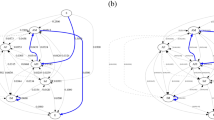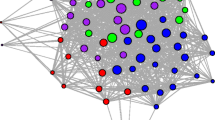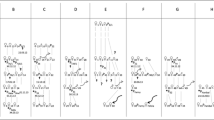Abstract
African papionins are well known for the diversity of their social systems, ranging from multilevel societies based on one-male-multifemale units (OMUs) to non-nested societies. However, the characteristics of Mandrillus societies are still unclear due to difficult observational conditions in the dense forests of central Africa. To elucidate the characteristics of mandrill societies and their social systems, I analysed the age–sex compositions, behaviours, and progression patterns of their horde/subgroups using videos of them crossing open places. The progressions were very cohesive, and the very large aggregations (169–442 individuals) had only 3–6 adult males (1.4–1.8 % of all individuals) and 11–32 subadult males (6.5–7.2 %). No herding behaviours were observed in the males, and most of the small clusters within the progressions were not analogous to the OMUs of a multilevel society but instead consisted of only adult females and immatures. The progressions of alert mandrills showed patterns similar to those observed in a non-nested social system: females with dependent infants were concentrated toward the rear and adult and subadult males toward the front. These results suggest that cohesive aggregations and a female-biased sex ratio are common characteristics of mandrill species. Mandrills may form female-bonded and non-nested societies, although their fission–fusion dynamics may be different from those typical of savannah baboons.

Similar content being viewed by others
References
Abernethy KA, White LJT, Wickings EJ (2002) Hordes of mandrills (Mandrillus sphinx): extreme group size and seasonal male presence. J Zool Lond 258:131–137
Altmann J (1980) Baboon mothers and infants. Harvard University Press, Cambridge
Altmann J, Hausfater G, Altmann SA (1985) Demography of Amboseli baboons, 1963–1983. Am J Primatol 8:113–125
Astaras C, Mühlenberg M, Waltert M (2008) Note on drill (Mandrillus leucophaeus) ecology and conservation status in Korup National Park, southwest Cameroon. Am J Primatol 70:306–310
Aurelli F, Schaffner CM, Boesch C, Bearder SK, Call J, Chapman CA, Connor R, Di Fiore A, Dunbar RIM, Henzi SP, Holekamp K, Korstjens AH, Layton R, Lee P, Lehmann J, Manson JH, Ramos-Fernandez G, Strier KB, van Schaik CP (2008) Fission-fusion dynamics: new research frameworks. Curr Anthropol 49:627–654
Bret C, Sueur C, Ngoubangoye B, Verrier D, Denoubourg J-L, Petit O (2013) Social structure of a semi-free ranging group of mandrills (Mandrillus sphinx): a social network analysis. PLoS ONE 8:e83015. doi:10.1371/journal.pone.0083015
Crook JH, Gartlan JS (1966) Evolution of primate societies. Nature 210:1200–1203
Devreese L, Huynen MC, Stevens JMG, Todd A (2013) Group size of a permanent large group of Agile Mangabeys (Cercocebus agilis) at Bai Hokou, Central African Republic. Folia Primatol 84:67–73
Gartlan JS (1970) Preliminary notes on the ecology and behavior of the drill, Mandrillus leucophaeus Ritgen, 1824. In: Napier JR, Napier PH (eds) Old World monkeys. Academic, New York, pp 445–473
Grueter CC, Chapais B, Zinner D (2012) Evolution of multilevel social systems in nonhuman primates and humans. Int J Primatol 33:1002–1037
Grüter CC, Zinner D (2004) Nested societies: convergent adaptations of baboons and snub-nosed monkeys? Primate Report 70:1–98
Harris EE (2000) Molecular systematics of the old world monkey tribe Papionini: analysis of the total available genetic sequences. J Hum Evol 38:235–256
Henzi P, Barrett L (2003) Evolutionary ecology, sexual conflict, and behavioural differentiation among baboon populations. Evol Anthropol 12:217–230
Hoshino J, Mori A, Kudo H, Kawai M (1984) Preliminary report on the grouping of mandrills (Mandrillus sphinx) in Cameroon. Primates 25:295–307
Itani J (1977) Evolution of primate social structure. J Hum Evol 6:235–243
Kappeler PM, van Schaik CP (2002) Evolution of primate social systems. Int J Primatol 23:707–740
Kudo H (1987) The study of vocal communication of wild mandrills in Cameroon in relation to their social structure. Primates 28:289–308
Kummer H (1968) Social organization of hamadryas baboons: a field study. The University of Chicago Press, Chicago
Mitani M (1989) Cercocebus torquatus: adaptive feeding and ranging behaviors related to seasonal fluctuations of food resources in the tropical rain forest of south-western Cameroon. Primates 30:307–323
Mori U (1979) Individual relationships within a unit. In: Kawai M (ed) Ecological and sociological studies of gelada baboons. Kodansha, Tokyo, pp 93–124
Ohsawa H (1979) The local gelada population and environment of the Gich area. In: Kawai M (ed) Ecological and sociological studies of gelada baboons. Kodansha, Tokyo, pp 3–46
Patzelt A, Zinner D, Fickenscher G, Diedhiou S, Camera B, Stahl D, Fischer J (2011) Group composition of Guinea baboons (Papio papio) at a water place suggests a fluid social organization. Int J Primatol 32:652–668
Range F, Fischer J (2004) Vocal repertoire of sooty mangabeys (Cercocebus torquatus atys) in the Taï National Park. Ethology 110:301–321
Rhine RJ (1975) The order of movement of yellow baboons (Papio cynocephalus). Folia Primatol 23:72–104
Rhine RJ, Tilson R (1987) Reactions to fear as a proximate factor in the sociospatial organization of baboon progressions. Am J Primatol 13:119–128
Rhine RJ, Forthman DL, Stillwell-Barnes R, Westlund BJ, Westlund HD (1979) Movement patterns of yellow baboons (Papio cynocephalus): the location of subadult males. Folia Primatol 32:241–251
Rogers ME, Abernethy KA, Fontaine B, Wickings EJ, White LJT, Tutin CEG (1996) Ten days in the life of a mandrill horde in the Lopé Reserve, Gabon. Am J Primatol 40:297–313
R Core Team (2013) R: a language and environment for statistical computing. R Foundation for Statistical Computing, Vienna. http://www.R-project.org/
Setchell JM, Dixson AF (2002) Developmental variables and dominance rank in adolescent male mandrills (Mandrillus sphinx). Am J Primatol 56:9–25
Setchell JM, Wickings EJ (2003) Sequence and timing of dental eruption in semi-free-ranging mandrills (Mandrillus sphinx). Folia Primatol 75:121–132
Setchell JM, Lee PC, Wickings EJ, Dixson AF (2002) Reproductive parameters and maternal investment in mandrills (Mandrills sphinx). Int J Primtol 23:51–68
Setchell JM, Charpentier M, Wickings EJ (2005) Sexual selection and reproductive careers in mandrills (Mandrillus sphinx). Behav Ecol Sociobiol 58:474–485
Shultz S, Opie C, Atkinson QD (2011) Stepwise evolution of stable sociality in primates. Nature 479:219–221
Silk JB, Altmann J, Alberts SC (2006) Social relationships among adult female baboons (Papio cynocephalus). I. Variation in the strength of social bonds. Behav Ecol Sociobiol 61:183–195
Snyder-Mackler N, Beehner JC, Bergman TJ (2012) Defining higher levels in the multilevel societies of geladas (Theropithecus gelada). Int J Primatol 33:1054–1068
Sueur C, Petit O (2010) Signals use by leader in Macaca tonkeana and Macaca mulatta: group-mate recruitment and behaviour monitoring. Anim Cogn 13:239–248
Swedell L (2011) African papionins: diversity of social organization and ecological flexibility. In: Cambell CJ, Fuentes A, MacKinnon KC, Panger M, Bearder SK (eds) Primates in perspective. Oxford University Press, New York, pp 241–277
Swedell L, Schreier A (2009) Male aggression towards females in hamadryas baboons: conditioning, coercion, and control. In: Muller MN, Wrangham RW (eds) Sexual coercion in primates and humans: an evolutionary perspective on male aggression against females. Harvard University Press, Cambridge, pp 244–268
Takenoshita Y, Ando C, Iwata Y, Yamagiwa J (2008) Fruit phenology of the great ape habitat in the Moukalaba-Doudou National Park, Gabon. Afr Study Monogr Suppl 39:23–39
White EC, Dikangadissi J-T, Dimoto E, Karesh WB, Kock MD, Abiaga NO, Starkey R, Ukizintambara T, White LJT, Abernethy KA (2010) Home-range use by a large horde of wild Mandrillus sphinx. Int J Primatol 31:627–645
Zinner D, Peláez F, Torkler F (2001) Group composition and adult sex-ratio of hamadryas baboons (Papio hamdryas hamadryas) in central Eritrea. Int J Primatol 22:415–430
Acknowledgments
I am grateful to Agence Nationale des Parcs Nationaux and Centre National de Recherche Scientifique et Technologique in Gabon for providing the permission required to carry out this research. I also thank Kyoto City Zoo and Dr. Delphine Verrier at the CIRMF for training me in age–sex classification; Prof. Juichi Yamagiwa, Dr. Yoshihiro Nakashima, Dr. Katharine Abernethy, and two reviewers for their helpful comments; and Koumba Sylvain, Biviga Steven, Nzamba Victor, and all the field assistants for their cooperation. This work was supported by the JSPS KAKENHI (grant nos. 19107007, 12J01884) and by a PROCOBHA project funded by JST/JICA, Science and Technology Research Partnership for Sustainable Development (SATREPS).
Author information
Authors and Affiliations
Corresponding author
Electronic supplementary material
Below is the link to the electronic supplementary material.
Online Resource 1 Video of the progression of mandrills in case 1. A subgroup crossed a fallen tree over a river.
Online Resource 2 Video of the progression of mandrills in case 2. A horde crossed a logging road 2 m wide.
Supplementary material 1 (MPG 158058 kb)
Supplementary material 2 (MPG 134074 kb)
About this article
Cite this article
Hongo, S. New evidence from observations of progressions of mandrills (Mandrillus sphinx): a multilevel or non-nested society?. Primates 55, 473–481 (2014). https://doi.org/10.1007/s10329-014-0438-y
Received:
Accepted:
Published:
Issue Date:
DOI: https://doi.org/10.1007/s10329-014-0438-y




